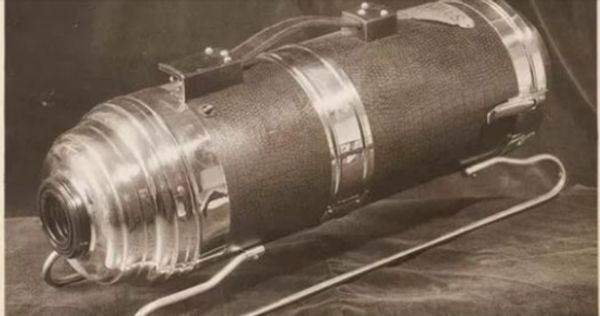One thing we can always be certain of is that things change over time. Nothing can stop this from happening. People change, technology changes, situations change as well. Change is inevitable! Look back at your own life, for example.

How much has truly changed? Particularly in terms of technological progress. It can be quite frightening to reflect on the extent of evolution. However, it can also be quite rejuvenating! Consider this “thing” as an example; we doubt you would recognize it… Unless you were alive in the 1930s, chances are you wouldn’t know what this is. If you do, congratulations! It looks rather peculiar, doesn’t it? Can you speculate on what this device might be?
It’s okay if you don’t recognize this strange object. But, we bet you’re curious! This odd-looking thing resembling a flask is actually a 1930’s vacuum cleaner called the Hercules! It’s quite different from the modern hoovers we use today. I’m currently watching my Roomba® clean as I type this! Can you imagine how revolutionary this machine was back then? Nowadays, we often forget how much technology has simplified our lives.

The Hercules Vacuum cleaner was a fashionable and elegant appliance in the past. The model shown had a crocodile skin covering, which made it a pricey buy. Adding to its luxury was the fact that it was available during the great depression, a period when most families struggled financially. If you’re familiar with this product, try introducing it to your children and see if they can figure out what it is. Chances are, they won’t have a clue!
The broom wasn’t improved until 1797 by a Massachusetts farmer who saw his wife having trouble sweeping. His creation, broomcorn, became popular.Naturally, over time, people became more inclined to laziness! Several new sweepers and brooms were introduced, but it wasn’t until the 1860s that Daniel Hess invented the first true vacuum cleaner. His patent described it as: “The essence of my invention is in sucking up fine dust and dirt using a stream of air.”

In 1869, Ives McGaffey from Chicago made a significant advancement. However, his design was more challenging to use compared to a typical broom. According to his patent, he aimed to solve the problem of dust and dirt in houses, which troubled many housekeepers. Unfortunately, his invention did not become popular.
Numerous designs emerged and disappeared. However, the vacuum cleaner was truly transformed by James Murray Spangler. A modest janitor from Canton, Ohio, aged 60, James dedicated himself to refining his design, even at the expense of his health. His invention surpassed others as it was not only upright but also portable. The simple yet effective machine efficiently sucked up dirt and blew it out into an attached pillowcase. In 1907, Spangler patented his creation and left his job to establish the Electric Suction Sweeper Company.

The air flow was created by utilizing a ceiling fan motor and paddle blades. To achieve this, he ingeniously attached a leather belt to a rotating brush from a carpet sweeper. The result was remarkable, as no one else could achieve such cleanliness without the assistance of a motor driven brush.
The Hoover came into existence after facing financial difficulties, leading him to sell his company to his cousin, Susan Hoover!
